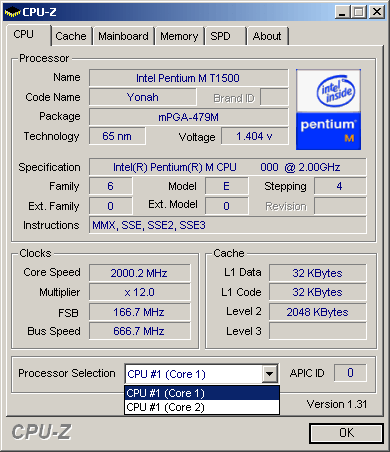Will Core Duo Notebooks Trade Battery Life For Quicker Response?
..., Faster Front Side Bus (FSB),
Two cores automatically entail more memory access. To prevent the Front Side Bus (FSB) in these new CPUs from becoming a bottleneck, Intel raised the FSB clock rate from 133 MHz to 166 MHz in this latest incarnation. Since Intel deploys a quad data rate protocol, four data transfers occur per cycle, resulting in speed designations of FSB533 and FSB667. That increase boosts maximum FSB bandwidth from 4.2 GB/s to 5.3 GB/s. This is still well below the maximum memory bandwidth of 10.76 GB/s possible for DDR2-667 dual channel memory technology.
The Intel Core Duo T2500 processor runs at a maximum clock rate of 2 GHz (HFM, or Highest Frequency Mode).
As a consequence of this improvement, installing DDR2-667 RAM in a Centrino Duo system removes the chances of the CPU being required to wait on memory for data delivery. Strictly speaking, DDR2-533 RAM, with a maximum bandwidth of 8.5 GB/s, is already sufficient to meet the needs of fast FSB667 in the dual core CPU. You should thus not worry if you look at a brand-new Yonah system and find it outfitted with DDR2-533 SO-DIMMs - faster DDR2-667 modules are more expensive and won't boost performance measurably.
| Platform | Processor Bus Speed | Memory Speed | Memory Configuration | |
|---|---|---|---|---|
| Napa | 5.33 GB/sec | 10.67 GB/sec8.53 GB/sec5.33 GB/sec4.26 GB/sec | DDR2-667DDR2-533DDR2-667DDR2-533 | (Dual-Channel)(Dual-Channel)(Single-Channel)(Single-Channel) |
| Sonoma | 4.25 GB/sec | 8.53 GB/sec6.40 GB/sec4.26 GB/sec3.20 GB/sec2.66 GB/sec | DDR2-533DDR2-400DDR2-533DDR2-400DDR-333 | (Dual-Channel)(Dual-Channel)(Single-Channel)(Single-Channel)(Single-Channel) |
However, this situation looks a little different when a Centrino Duo system uses a graphics core that is integrated into the chipset, instead of a graphics chip with its own dedicated video memory. In that case, the CPU and the integrated graphics core must share memory bandwidth, a technology known as Unified Memory Architecture (UMA), sometimes also called shared memory architecture. This requires allocating an appreciable portion of memory bandwidth to handling video data. In notebooks with shared memory graphics, therefore, you should insist on faster DDR2-667 memory modules.
Get Tom's Hardware's best news and in-depth reviews, straight to your inbox.
Current page: ..., Faster Front Side Bus (FSB),
Prev Page Yonah: Pentium M Successor With Two Cores Next Page ...and Other Important Enhancements